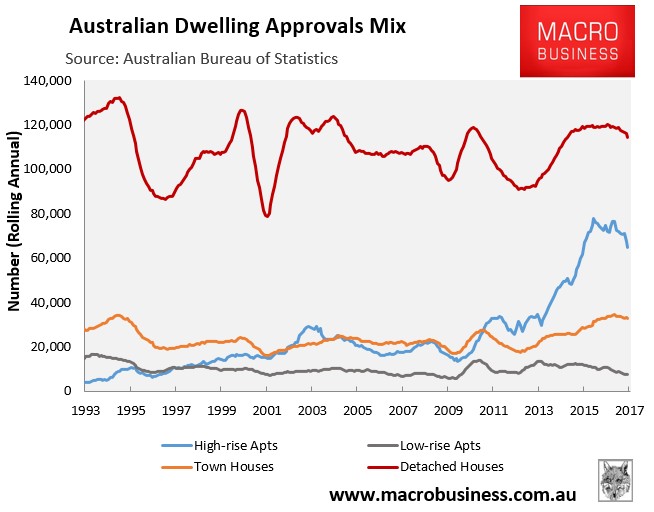Professor Brendan Gleeson from the University of Melbourne has penned a somewhat contrarian article questioning the efficacy of what he calls “vertical sprawl” – the proliferation of low-quality high-rise apartments across the East Coast of Australia:
The towers crowding out the centre of Australian cities are a symptom of failed governance and planning, and it’s threatening any transition to ecocities…
To understand the major barrier to making our cities more sustainable and environmentally friendly places, just stand in the centre of almost any Australian city and look up. The chances are you will be in the shadow of a tall building totally reliant on air-conditioning and made from energy-intensive materials like steel.
Poet Dorothea Mackellar once lauded Australia for its “wide horizons” and “sweeping plains” but the country is now a land of high rises. Incredibly for its small population, Australia ranks sixth in the world for the number of buildings standing above 150m.
It has almost 100 such skyscrapers, putting it only behind more populous nations like China, the US, Japan, South Korea, and the small but land-constricted United Arab Emirates. Australia actually ranks fifth in the world for the number of buildings standing over 100m at 352.
Professor Brendan Gleeson, from the University of Melbourne, calls it “vertical sprawl” and it is spreading as more and more high rises are approved. He warns it is a symptom of a serious problem that threatens to block our cities from ever becoming sustainable ecocities — weak metropolitan governance that has left planning hostage to short-term profit seeking.
“By vertical sprawl I mean the poor-quality, high-density buildings that are increasingly compacting our cities,” says Professor Gleeson, the Director of the Melbourne Sustainable Society Institute. “They are poorly designed, poorly orientated and are being built too close together with little or no regard for urban and green spaces.”
Indeed, he notes that an international study has found that high-rise developments in Melbourne were being allowed at sometimes four times the maximum densities of Hong Kong, New York and Tokyo.
“The vertical sprawl has been driven by a combination of property developers seeking to maximise their yield from the high-value land in our inner cities, and a lack of regulation that has simply re-zoned areas for development and then just let the market rip.”
While there are suggestions that compact cities of high rises can be more sustainable and free up space, Professor Gleeson says the evidence indicates that high rises are much more energy and resource intensive than medium-density developments, such as low-rise buildings that don’t need lifts.
“It is very hard to design high rises that aren’t reliant on air-conditioning, so from the start you are on the back foot in terms of reducing energy consumption,” says Professor Gleeson.
“While high-density living is promoted as a supposedly green shift, it is these high-rise buildings that will prove the most vulnerable to climate change and rising temperatures”…
“We have enough evidence now to show that tall residential buildings perform surprisingly badly in terms of both water and energy consumption,” says Professor Gleeson. “You might build high-rise buildings for various reasons, such as if there is a land shortage, but there isn’t any environmental reason for building them.
“The first thing we have to do is dump this idea that we should Manhattanise Australian cities. Population growth means we do need to move towards more higher-density living, but we have to do it a lot better than we have been.
“What the evidence shows is that well-designed medium-density development comes out best.”
So much for the notion that limiting urban expansion and cramming people into high-rises is the environmentally friendly and sustainable thing to do.
Turns out that our major cities have instead merely replaced unsustainable urban sprawl with unsustainable vertical sprawl, with the resulting “vertical slums” of micro-apartments, as well as urban heat islands that lack greenery and recreation space.


